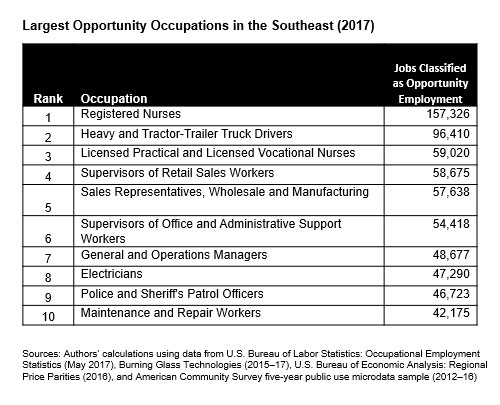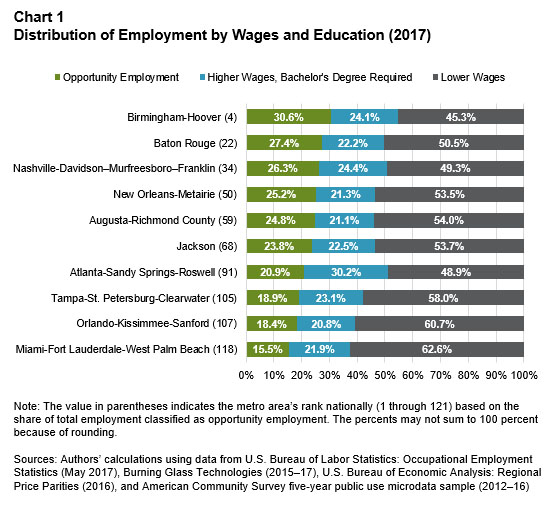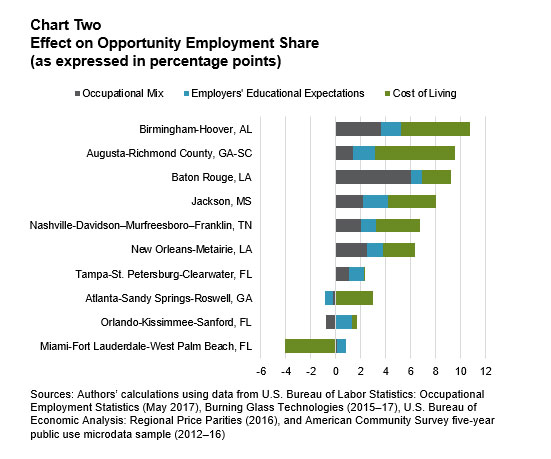Keith Wardrip, Kyle Fee, and Lisa Nelson
September 4, 2019
2019-04
https://doi.org/10.29338/wc2019-04
Opportunity occupations—or opportunity employment—are jobs that do not require a bachelor’s degree and pay above a regionally adjusted median wage. This article takes a look at trends in the Southeast. For a deeper look at trends in opportunity occupations, see also "Opportunity Occupations Revisited: Exploring Employment for Sub-Baccalaureate Workers Across Metro Areas and Over Time."
College-educated workers typically have greater success in the labor market than workers without a bachelor’s degree, as measured by both earnings and rates of employment.1 In light of research indicating a "polarization" of the labor market in favor of higher- and lower-wage jobs,2 it is worth asking, do certain regional economies offer greater opportunities for the more than two-thirds of adults without a bachelor’s degree?
Our research
Our research explores the jobs available in 121 of the largest U.S. metro areas. In each, we divide employment into one of three categories based on the annual median wage and the educational expectations of employers hiring to fill open positions:
- Opportunity employment is accessible to workers without a bachelor’s degree and pays above the national annual median wage ($37,690), adjusted up or down to reflect the local cost of living (that is, the local wage threshold). Occupations characterized by a high level of opportunity employment are referred to as opportunity occupations.
- Equally well-compensated jobs that aren’t accessible to workers without a bachelor’s degree are classified as higher-wage employment requiring a bachelor’s degree.
- Lower-wage employment can be found in occupations that pay below the local wage threshold.
This post summarizes our findings on 10 metro areas in the Sixth Federal Reserve District: Atlanta-Sandy Springs-Roswell, Georgia; Augusta-Richmond County, Georgia-South Carolina; Baton Rouge, Louisiana; Birmingham-Hoover, Alabama; Jackson, Mississippi; Miami-Fort Lauderdale-West Palm Beach, Florida; Nashville-Davidson–Murfreesboro-Franklin, Tennessee; New Orleans-Metairie, Louisiana; Orlando-Kissimmee-Sanford, Florida; and Tampa-St. Petersburg-Clearwater, Florida.
Sixth District findings
Opportunity employment takes many different forms. As the table illustrates, the largest opportunity occupations in these 10 metro areas represent a true cross section of the economy, ranging from health care (registered nurses and licensed practical/vocational nurses) to supervisory positions (retail sales and office and administrative support) to the skilled trades (electricians). However, the individual character of a regional economy emerges when looking at the top 10 in each metro area. For example, welders in Baton Rouge, secretaries in Birmingham, and assembly line workers in Nashville are top-10 opportunity occupations in these markets, even though they are not among the largest sources of opportunity employment in the Sixth District.

Just as the largest opportunity occupations vary somewhat from place to place, we find that opportunity employment as a share of total employment varies regionally as well. As chart 1 illustrates, the opportunity employment share ranges from 30.6 percent in Birmingham—fourth-highest among the 121 metro areas analyzed—to 15.5 percent in Miami, which ranked 118th. Chart 1 also highlights how the balance of employment can vary across regional economies. For example, compared with Atlanta, Orlando’s economy consists of relatively few higher-wage jobs requiring a bachelor’s degree (20.8 percent) and a significant level of lower-wage employment (60.7 percent).

Our research also allows us to disentangle the effects of several factors that influence a regional economy’s level of opportunity employment, including the mix of occupations, the level of education that employers seek when filling open positions, and the area’s cost of living. By comparing actual opportunity employment shares with hypothetical levels that are based on the national averages for these factors, we can discern the effects of each factor.
For many of these metro areas, all three factors expand the local opportunity employment share when compared with their hypothetical levels using national averages (see chart 2). The lower cost of living is the primary driver in Birmingham and Augusta, whereas in Baton Rouge, the mix of occupations has the greatest impact. The opportunity employment share in Miami is lower than its hypothetical value because even though employers’ lower educational requirements modestly expand opportunity in the region, fewer jobs pay wages high enough to compensate for its higher cost of living.

How can opportunity employment be expanded locally?
A regional economy’s level of opportunity employment is influenced by the types of jobs available, the level of education that employers seek when filling job openings, and the relationship between wages and costs. The multifaceted nature of this issue means local opportunity employment could be expanded through any number of approaches, such as:
- Economic development strategies that prioritize industries characterized by high levels of opportunity employment
- A reconsideration by employers of their hiring requirements and a commitment to objectively assessing the skills of workers from a variety of educational backgrounds
- An expansion of both private sector and public sector programs for postsecondary skills development
- Efforts to better align regional wages and costs, possibly through modest wage increases for lower-wage workers or through efforts to expand the supply of affordable housing.
For more information on these metro areas and 121 of the largest metros in the country, please see our report "Opportunity Occupations Revisited: Exploring Employment for Sub-Baccalaureate Workers Across Metro Areas and Over Time." Related one-page fact sheets describe the 10 largest opportunity occupations in each of the 121 metro areas analyzed. Explore the Opportunity Occupations Monitor, an interactive data tool, to gain more information about the share of opportunity employment across geographies and over time.
Keith Wardrip is community development research manager at the Federal Reserve Bank of Philadelphia, Kyle Fee is a senior policy analyst at the Federal Reserve Bank of Cleveland, and Lisa Nelson is community development research manager, also at the Cleveland Fed.
_______________________________________
1 See https://www.bls.gov/emp/tables/unemployment-earnings-education.htm.
2 David H. Autor, Lawrence F. Katz, and Melissa S. Kearney, "The Polarization of the U.S. Labor Market." American Economic Review 96, no. 2 (2006): 189–94.


